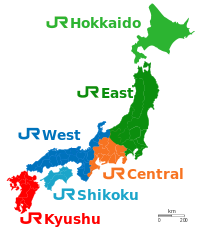
Back مجموعة السكك الحديدية اليابانية Arabic Japan Railways Catalan Japan Railways Group Danish Japan Railways German Ιαπωνικοί Σιδηρόδρομοι Greek JR Esperanto Japan Railways Spanish جیآر Persian JR (rautatiekonserni) Finnish Japan Railways French


The Japan Railways Group, more commonly known as the JR Group (JRグループ, Jeiāru Gurūpu) or simply JR, is a group of railway companies in Japan that underwent division and privatization[1] of the government-owned Japanese National Railways (JNR) on April 1, 1987. It consists of six passenger railway companies, one freight railway company, and two non-service companies. Most of the liability of the JNR was assumed by the JNR Settlement Corporation.
The JR Group operates a large proportion of intercity rail service (including the Shinkansen high-speed rail lines) and commuter rail service.
JR Hokkaido, JR Shikoku, and JR Freight (JRF) are governed by the Act for the Passenger Railway Companies and Japan Freight Railway Company[2], also known as the JR Companies Act, and are under the control of the public Japan Railway Construction, Transport and Technology Agency (JRTT), while JR East, JR Central, JR West, and JR Kyushu are completely floated in the stock market; in addition, JR East, JR Central and JR West are constituents of the Nikkei 225 and TOPIX 100 indices. Because the railways used to be owned by the government, Japanese people generally make a distinction between JR railways (including former JR lines that are now third sector) and other private railways, and JR railways are almost always denoted differently from other private railways when shown on maps.[3]
- ^ See Japanese National Railways division and privatization.
- ^ 旅客鉄道株式会社及び日本貨物鉄道株式会社に関する法律, Ryokaku Tetsudō kabushiki gaisha oyobi Nippon Kamotsu Tetsudō kabushiki gaisha ni kan-suru hōritsu, Act No. 88 of December 4, 1986
- ^ http://www.jreast.co.jp/renrakuteiki/index.html Archived 2016-04-06 at the Wayback Machine Using Suica Railway Pass, connect from JR to Private Rail/Metro!